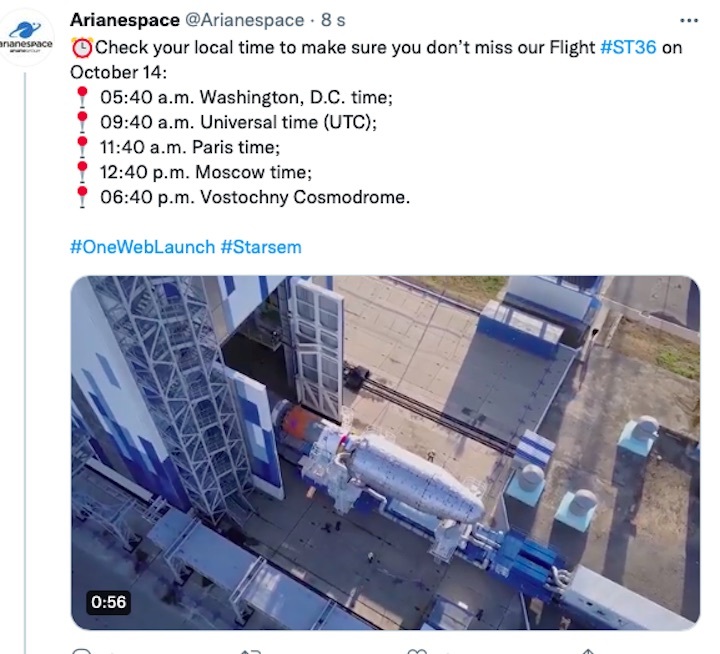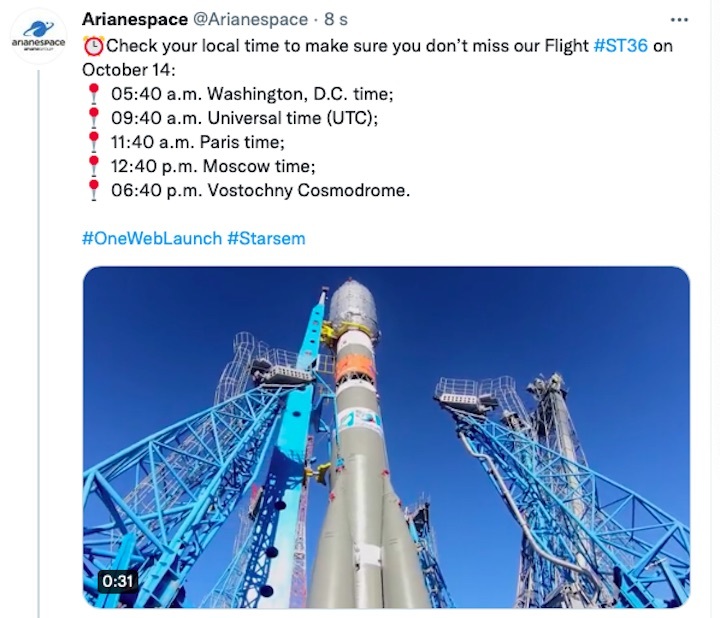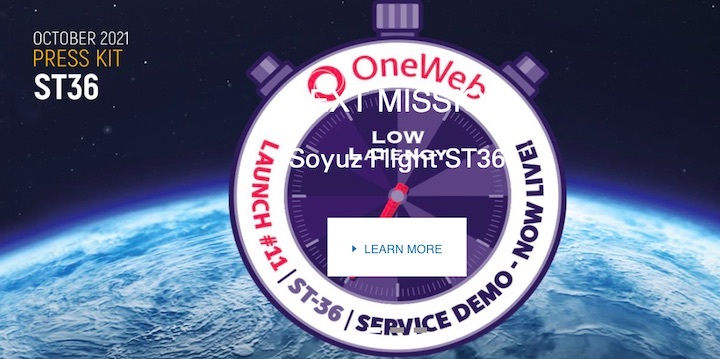13.10.2021


+++
MISSION DESCRIPTION
Arianespace’s tenth launch of 2021 with the seventh Soyuz of the year will place its satellite passengers into low Earth orbit. The launcher will be carrying a total payload of approximately 5 797 kg.
The launch will be performed from Vostochny, in Russia.

Flight ST36, the sixth commercial mission from Vostochny in Russia performed by Arianespace and its Starsem affiliate, will put 36 of OneWeb’s satellites bringing the total fleet to 358 satellites into a near-polar orbit at an
altitude of 450 kilometers. After separation, the satellites will raise themselves to their operational orbit.
OneWeb’s mission is to bring internet everywhere to everyone, by creating a global connectivity platform through a next generation satellite constellation in low Earth orbit. OneWeb’s constellation of 648 satellites will deliver high-speed, low-latency enterprise grade connectivity services to a wide range of customer sectors including enterprise, government, maritime and aviation customers. Central to its purpose, OneWeb seeks to bring connectivity to every unconnected area where fiber cannot reach, and thereby bridge the digital divide.
Once deployed, the OneWeb constellation will enable user terminals that are capable of offering 3G, LTE, 5G and Wi-Fi coverage, providing high-speed access globally & by air, sea and land.
DID YOU KNOW?
As OneWeb’s constellation will ultimately consist of 648 satellites, this launch will hit the mark of more than half of the constellation being in orbit. The 324th satellite, deployed at 1 hour and 18 minutes during the first separation will mark this milestone.
Quelle: arianespace
----
Update: 14.10.2021
.
Launch of Soyuz-2.1b rocket carrier with OneWeb satellites allowed, says Roscosmos
The State Commission has approved the upcoming launch of the Soyuz-2.1b rocket carrier on Thursday, which meant to place into orbit 36 British OneWeb satellites along with the Fregat booster, according to Roscosmos.
Roscosmos specified that the State Commission held a meeting at the Vostochny Cosmodrome in Russia’s Far East. "Following the test results, the Commission decided to refuel the missile carrier and launch it at 12:40:10 p.m. Moscow Time on October 14, 2021," the statement reads.
After the launch, the satellites will be separated from the upper stage in several stages.
Director General of Roscosmos Dmitry Rogozin has arrived at the Vostochny Cosmodrome to watch the launch, according to his Telegram channel.
Following the launch, the number of British space vehicles is going to climb to 358. The Glavkosmos state company, the Arianespace launch service provider and the French-Russian company Starsem carry out the work.
The first six OneWeb satellites entered orbit from the Guiana Space Centre on a Soyuz-ST missile on February 28, 2019. A total of 34 spacecraft were launched from the Baikonur Cosmodrome on February 7, 2020, and the same number - on March 21, 2020. In December last year, OneWeb satellites were launched from the Vostochny Cosmodrome for the first time. Then, the launches from the Vostochny Cosmodrome took place on March 25, April 26, May 28 and July 1, 2021, and from the Baikonur Cosmodrome - on August 22 and September 14, 2021.
Quelle: TASS
+++
Arianespace launches 36 new OneWeb internet satellites into orbit on Soyuz rocket
A Soyuz rocket launched 36 new OneWeb internet satellites into orbit from Russia early Thursday (Oct. 14), pushing the communications provider past the halfway mark to completing its growing megaconstellation.
The OneWeb satellites soared into space atop a Russian-built Soyuz rocket from the Vostochny Cosmodrome in a mission operated by French company Arianespace. Liftoff occurred at 5:40 a.m. EDT (0940 GMT).
The spacecraft will deploy from the Soyuz into a near-polar orbit with an altitude of 280 miles (450 kilometers), Arianespace representatives wrote in a mission description. These deployments will occur in four-satellite batches, the last of which will take place about 3 hours and 51 minutes after liftoff.

The solar-powered satellites will then make their own way to their operational orbit, which lies 746 miles (1,200 km) above Earth. They'll have lots of company up there; the constellation already consists of 322 spacecraft, all of which were lofted by Arianespace.
And many more will join this group over the coming weeks and months. The London-based OneWeb is building a constellation of 648 satellites, which will beam broadband internet service to people around the globe.
"Once deployed, the OneWeb constellation will enable user terminals that are capable of offering 3G, LTE, 5G and Wi-Fi coverage, providing high-speed access globally — by air, sea and land," Arianespace representatives wrote in the mission description.

OneWeb plans to start providing such service to northern regions of the planet by the end of this year, with global coverage expected to follow in 2022.
The company will have some competition for this product. For example, SpaceX has already launched more than 1,700 of its Starlinkbroadband satellites (with many more the come) and is currently beta-testing the network's service. And Amazon plans to loft its own internet-satellite constellation, though none of these spacecraft have left the ground to date.
Correction: A previous version of this story misstated the cosmodrome used to launch the OneWeb 11 mission. It is the Vostochny Cosmodrome in Russia, not Baikonur Cosmodrome in Kazakhstan.
Quelle: SC

